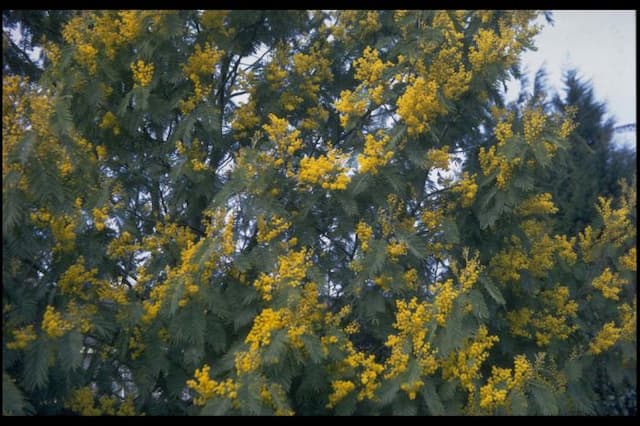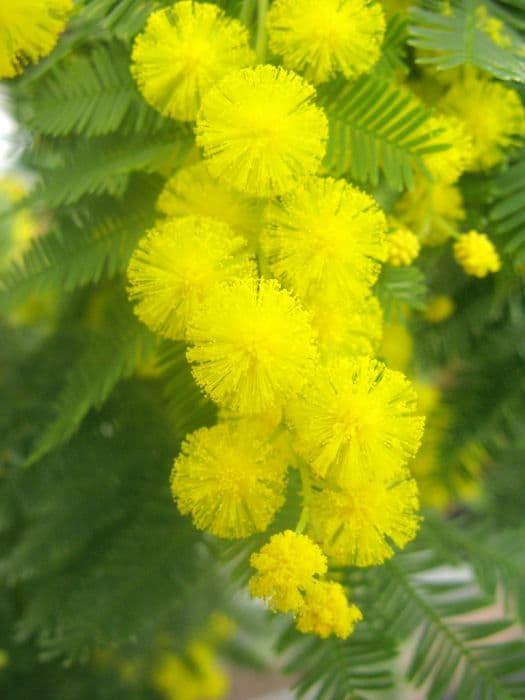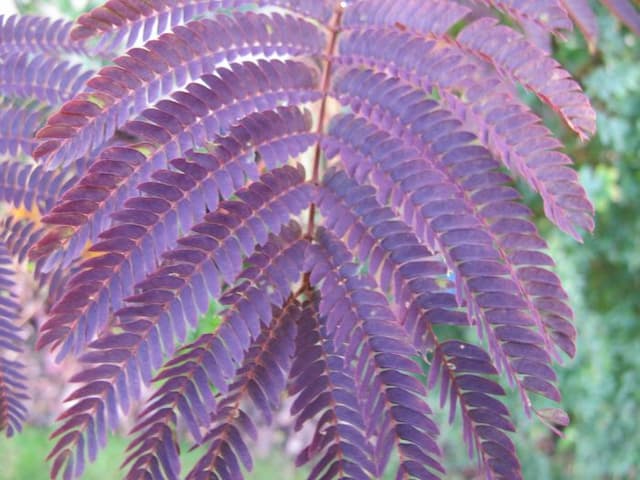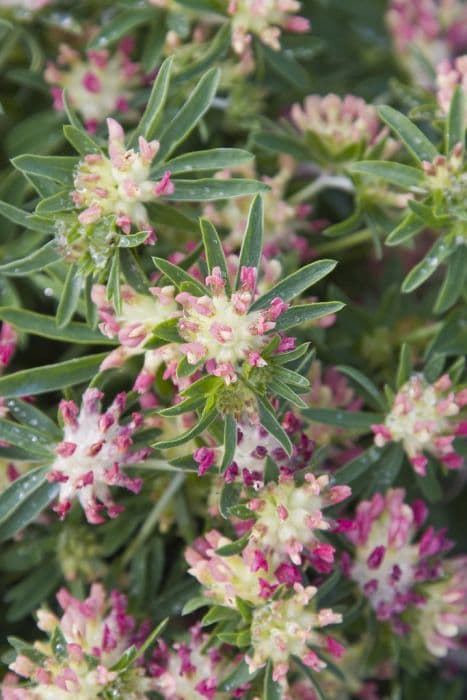Spring Vetchling Lathyrus vernus
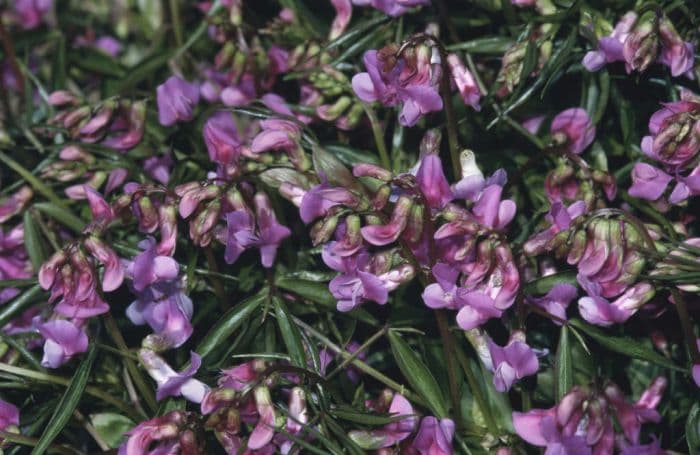
ABOUT
Spring vetchling, as it's commonly known, is a perennial plant that typically blooms in the springtime. It possesses a bushy yet compact appearance, with stems that are adorned with pairs of small, rounded leaves that are a vibrant green color. These leaflets are generally smooth-edged, giving the foliage a neat and well-kept appearance. As the days start to lengthen, the plant brings forth a profusion of colorful flowers. These blooms are characterized by their butterfly-like shape, which is typical of plants in its family. The flowers range in hue from purplish-pink to bluish-violet, often with a gradient or mottled pattern that adds to their allure. After the flowering season, the plant produces pods which encase the seeds, and these pods often have a slightly fuzzy texture. The overall form of the spring vetchling is somewhat rounded and full, creating an appealing visual display that can add a touch of early color to gardens and natural settings.
About this plant
 Names
NamesSynonyms
Spring Vetch, Spring Pea, Eternal Pea, Bush Vetch.
Common names
Lathyrus vernus var. brachypterus, Lathyrus vernus var. flaccidus, Orobus vernus, Lathyrus vernus subsp. vernus.
 Toxicity
ToxicityTo humans
The plant known as the spring vetch is considered mildly toxic to humans if ingested. However, the level of toxicity in Lathyrus vernus typically does not cause severe reactions. Some species in the Lathyrus genus contain a compound known as ODAP (beta-N-oxalyl-L-alpha,beta-diaminopropionic acid), which can lead to a condition known as lathyrism if consumed in large quantities over time. Lathyrism is characterized by symptoms such as muscle weakness and paralysis, particularly in the lower limbs. Consuming parts of spring vetch may lead to gastrointestinal upset, characterized by nausea, vomiting, diarrhea, and abdominal pain.
To pets
The plant referred to as spring vetch is also mildly toxic to pets, including cats and dogs. As with humans, the severity of the symptoms typically is not high unless consumed in large amounts. Pets that ingest parts of the spring vetch may experience mild gastrointestinal upset, with symptoms such as vomiting, diarrhea, and possible abdominal discomfort. If you suspect your pet has ingested a significant amount of spring vetch or is showing signs of severe distress, you should contact a veterinarian.
 Characteristics
CharacteristicsLife cycle
Perennials
Foliage type
Deciduous
Color of leaves
Green
Flower color
Mixed
Height
1-2 feet (30-60 cm)
Spread
1-2 feet (30-60 cm)
Plant type
Herb
Hardiness zones
4
Native area
Europe
Benefits
 General Benefits
General Benefits- Ornamental Value: Lathyrus vernus, commonly known as Spring Vetchling, adds aesthetic appeal to gardens with its bright purple flowers that bloom in early spring.
- Low Maintenance: Spring Vetchling is a hardy perennial that requires minimal care once established, making it suitable for novice gardeners.
- Attracts Pollinators: The vibrant flowers attract bees, butterflies, and other pollinating insects, supporting local ecosystems.
- Drought Tolerant: Once established, it can tolerate periods of dryness, reducing the need for frequent watering.
- Grows in Shade: Spring Vetchling can thrive in partially shaded areas where other plants might struggle, making it versatile for garden design.
- Non-Invasive: Unlike some other members of the pea family, it typically does not spread uncontrollably, making it garden-friendly.
- Deer Resistant: Its foliage and flowers are not highly preferred by deer, which can help to maintain its appearance in areas with deer populations.
 Medical Properties
Medical PropertiesThis plant is not used for medical purposes.
 Air-purifying Qualities
Air-purifying QualitiesThis plant is not specifically known for air purifying qualities.
 Other Uses
Other Uses- Spring Pea Dye: The flowers of Lathyrus vernus can be used to create a natural dye due to their pigmentation, offering a range of colors depending on the mordant used.
- Biological Pest Control: Lathyrus vernus can be part of a garden ecosystem that attracts beneficial insects that prey on harmful pests.
- Educational Tool: The plant can be used in schools or educational programs to teach about early blooming plant species and their role in ecosystems.
- Culinary Decoration: Although the plant and its seeds are not edible, its flowers can be used to decorate dishes in high-end gastronomy after ensuring they are free of pesticides and other chemicals.
- Photography Subject: Photographers may use Lathyrus vernus as a subject to capture the essence of early spring in temperate woodlands due to its early flowering.
- Companion Planting: Lathyrus vernus can be used in companion planting to create aesthetically pleasing garden designs with its early spring blooms.
- Study of Plant Adaptation: The plant can provide insight into the adaptation of species to different light conditions as it blooms early in spring before canopy closure.
- Soil Erosion Prevention: By planting Lathyrus vernus in appropriate areas, its roots can help stabilize soil and prevent erosion in early spring.
- Phenology Studies: Spring Pea's early blooming can be monitored for studies of climate change and its impact on plant life cycles.
- Artistic Inspiration: Artists may use the striking appearance and seasonal cycle of the Spring Pea to inspire works of art related to themes of renewal and the transient nature of life.
Interesting Facts
 Feng Shui
Feng ShuiThe Spring Vetchling is not used in Feng Shui practice.
 Zodiac Sign Compitability
Zodiac Sign CompitabilityThe Spring Vetchling is not used in astrology practice.
 Plant Symbolism
Plant Symbolism- Spring Awakening: Lathyrus vernus, commonly known as Spring Vetchling, often symbolizes the arrival of spring due to its early blooming schedule.
- Youthful Joy: The vibrant colors of the Spring Vetchling flowers can represent youthful exuberance and the joy of youth.
- New Beginnings: As an early bloomer, the Spring Vetchling often signifies new beginnings or the start of a new venture.
- Bliss: The beauty and delicate structure of the flower may symbolize bliss and contentment.
 Water
WaterSpring pea, or Lathyrus vernus, prefers consistent moisture, especially during its active growing phase in the spring and early summer. Ensure the soil is well-draining and remains evenly moist but not waterlogged. You may need to water the plant once a week with about one gallon of water, although you should always check the soil moisture before watering; it should be damp to the touch, about an inch below the surface. During the dormant phase in late summer to early fall, you can reduce watering. Overwatering can lead to root rot, so moderation is key.
 Light
LightSpring pea thrives in partial shade to full sun, so choose a spot that receives at least four hours of direct sunlight per day, but is also protected from the hot afternoon sun, which can be too intense. An ideal location would provide morning sunlight and dappled shade in the afternoon, which would mimic the woodland edges where it naturally grows.
 Temperature
TemperatureSpring pea can withstand a fair range of temperatures, but thrives best in moderate conditions. It can survive minimum temperatures down to around 20°F, while its preferred growing range is between 60°F and 70°F. Excessive heat can be detrimental to the plant, so avoid placing it in locations where temperatures exceed 80°F for prolonged periods.
 Pruning
PruningPruning spring pea is essential for maintaining its shape and encouraging new growth. After flowering, usually in late spring or early summer, prune the plant by cutting back the spent flower stems. This can promote a second, albeit less abundant, flowering. Prune lightly once a year to remove any dead or weak stems and to keep the growth in check. The best time for pruning is just after the plant has finished its main flowering period.
 Cleaning
CleaningAs needed
 Soil
SoilSpring vetch requires well-drained soil enriched with organic matter, in a mix of two parts garden soil, one part compost or leaf mold, and one part sand or perlite. The ideal pH for this plant should range from 6.0 to 7.0 to support healthy growth and flowering.
 Repotting
RepottingSpring vetch does not typically require frequent repotting; it should be repotted only when it has outgrown its current container, typically every 2-3 years to refresh the soil and provide room for growth.
 Humidity & Misting
Humidity & MistingSpring vetch prefers moderate humidity levels but is quite adaptable and does not have specific humidity requirements; it thrives in the humidity levels found in most outdoor environments.
 Suitable locations
Suitable locationsIndoor
Place in bright, indirect light; ensure adequate airflow.
Outdoor
Plant in partial shade; protect from hot afternoon sun.
Hardiness zone
4-8 USDA
 Life cycle
Life cycleLathyrus vernus, commonly known as spring vetchling or spring pea, begins its life cycle as a seed, sown in well-drained soil usually in autumn or early spring. Upon germination, which requires a period of cold stratification to break dormancy, the seedlings develop roots and shoots, emerging from the soil as small plants. As spring progresses, the plant enters the vegetative stage, producing compound leaves that capture sunlight for photosynthesis and support further growth. By late spring to early summer, the spring vetchling enters the flowering stage, where it produces showy purple, pink, or even white flowers, which are pollinated by insects, leading to fertilization. Following pollination, the plant develops pods containing seeds, signifying the reproductive stage. Once mature, the pods dry and release seeds, completing the life cycle and enabling the spring vetchling to proliferate in the environment.
 Propogation
PropogationPropogation time
Spring
The Spring Vetch, commonly known as Lathyrus vernus, can be propagated by division or from seed, but the most popular method is seed propagation. To propagate the Spring Vetch using seeds, one should collect the seeds when the pods have matured, which typically occurs in late summer. Once collected, the seeds need to be sown immediately or can be stored and then stratified for several weeks before the spring sowing to ensure germination. Sow the seeds about 1/4 inch deep (approximately 6 mm) in a well-draining soil mix. Keep the soil consistently moist but not waterlogged, and with patience and proper care, seedlings should appear in the coming spring. Seed propagation captures the genetic diversity of the species and can result in a pleasing variation among the progeny.
